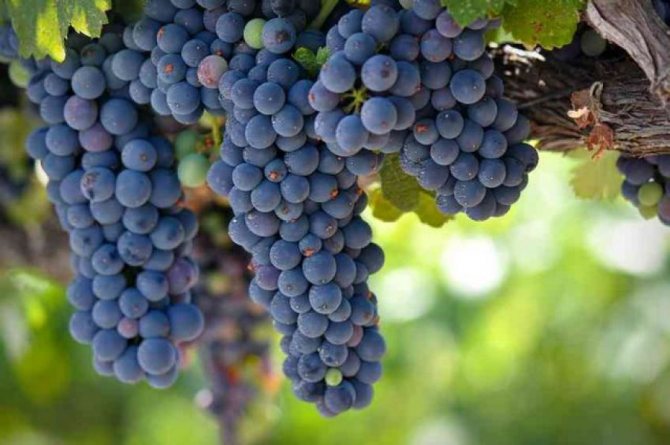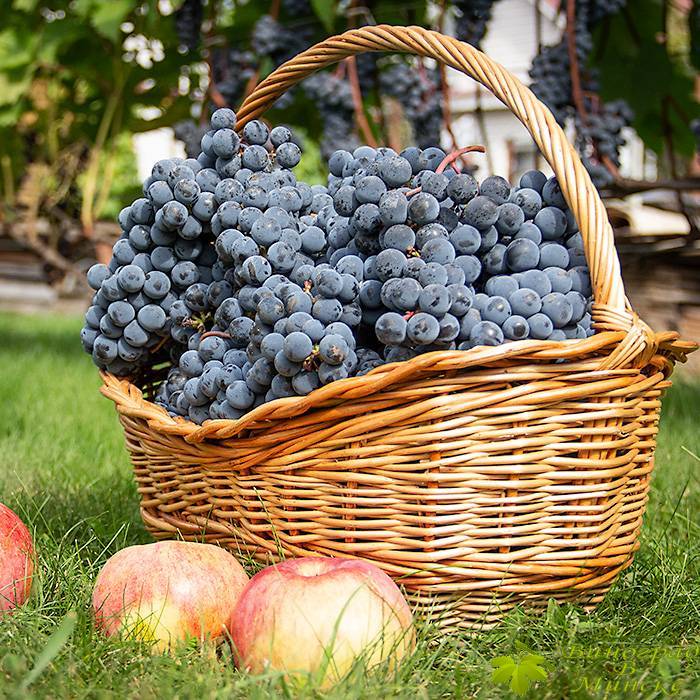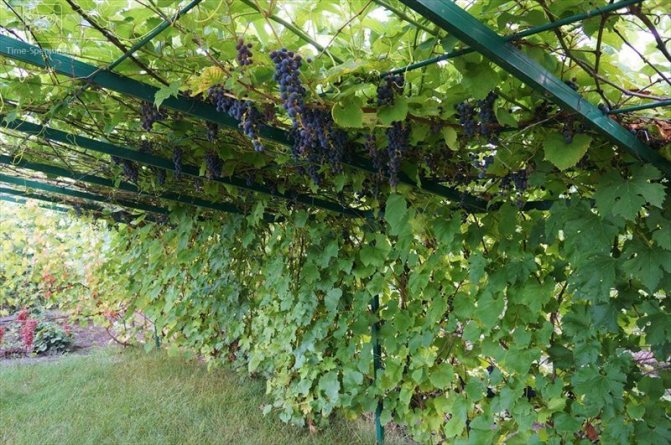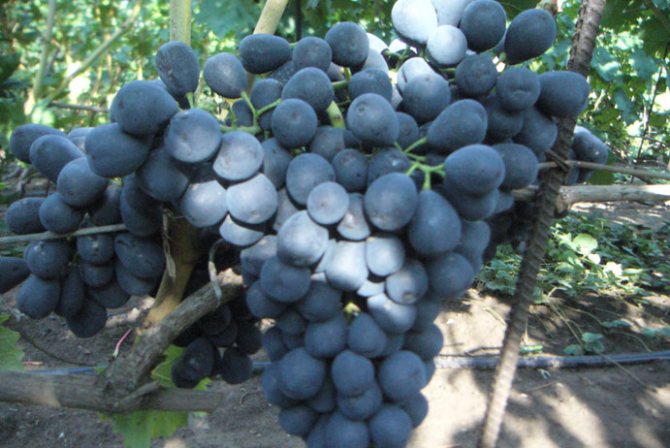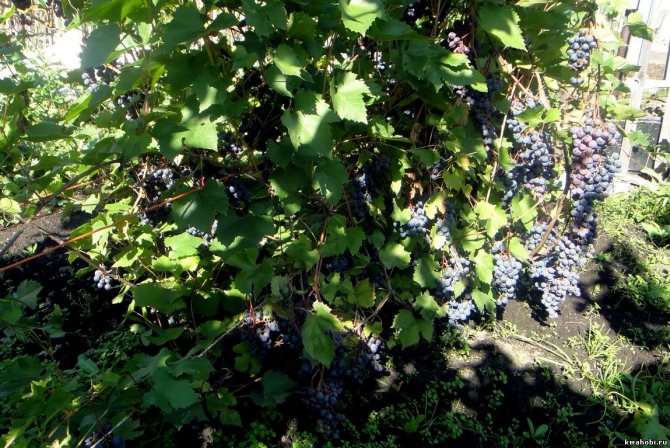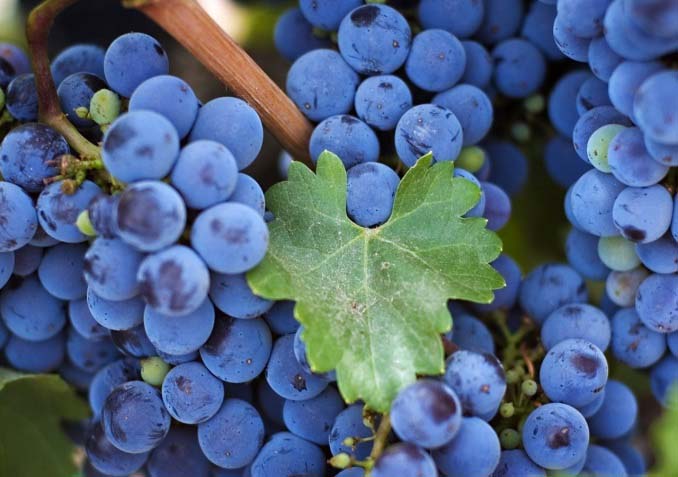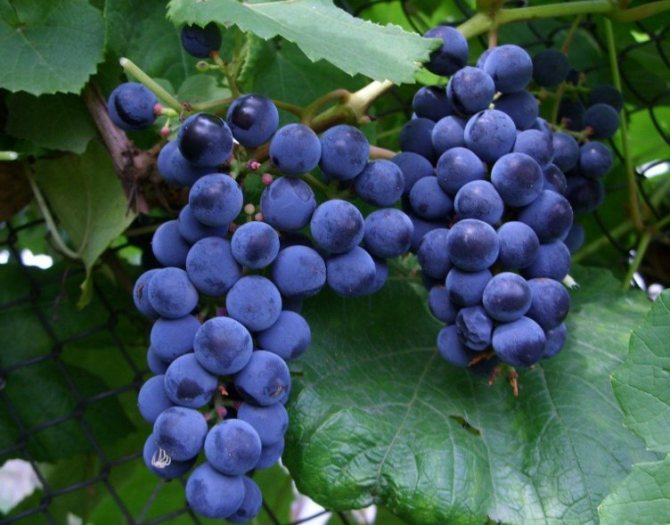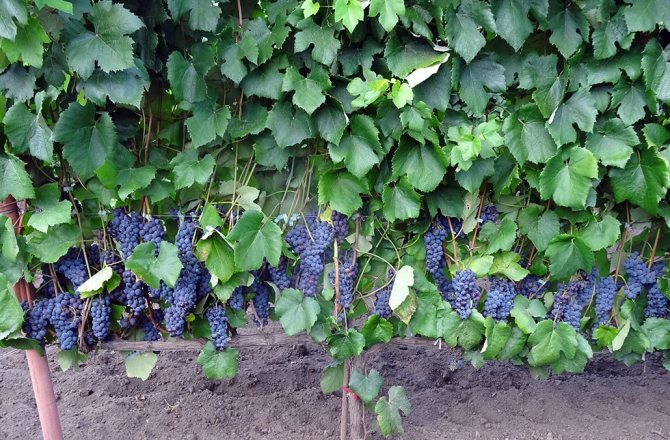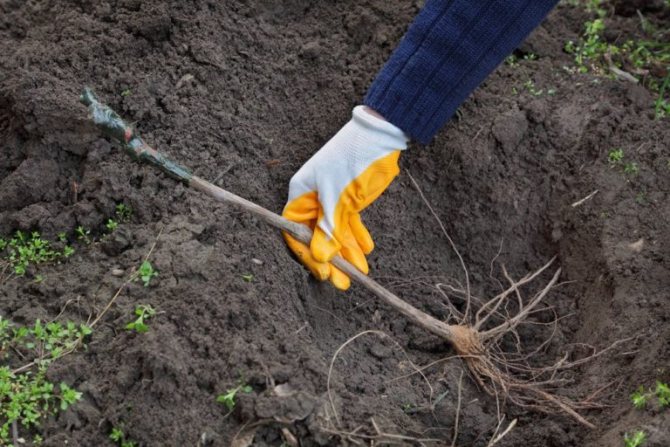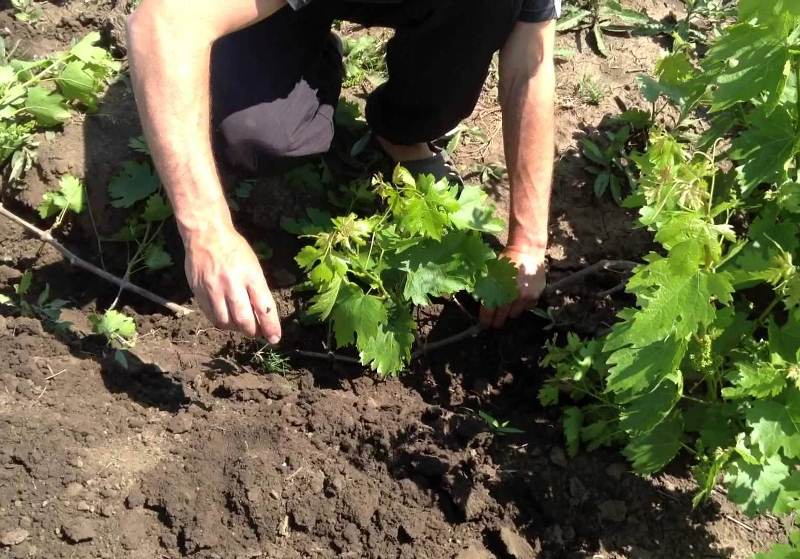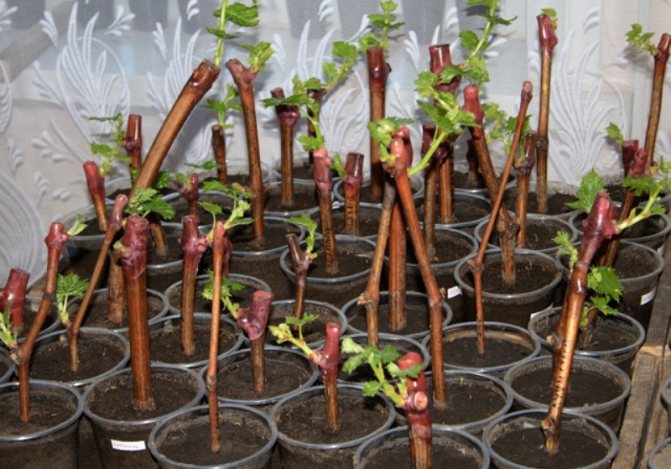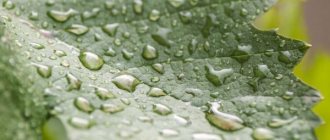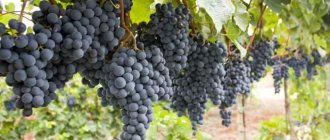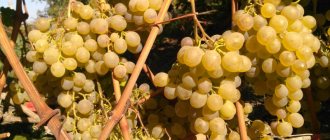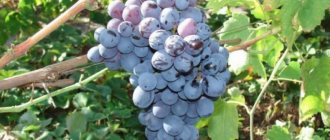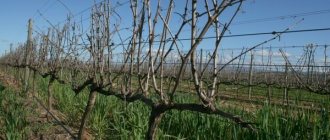Gardeners in cooler climates are in constant search of early and frost-resistant grape varieties. Winegrowers recommend zilga grapes, obtained by crossing Smuglyanka, Dvietes zila and Yubileyny Novgorod by the Latvian breeder P. Sukatnieks. A hybrid blue (zilga word means blue) grape has a number of remarkable qualities.

Origin story
Zilga was born in 1964 thanks to the Latvian breeder P. Sukatnieks. By that time, he had already bred about a hundred bright, successful grape varieties. However, the winegrower did not stop his curious experiments, trying to create grapes adapted to the harsh climate of northern Europe, which would satisfy all the needs of society.
Zilga was created on the basis of Russian varieties "Smuglyanka", "Jubilee Novgorod" and the Latvian "Dvietes". This type of grape is able to withstand 30-degree frosts, winters well without shelter, even in snowless periods. The new variety of grapevine has gained wide recognition in Lithuania and Latvia, Belarus and other countries with an uneven climate.
Note!
According to its characteristics, Zilga belongs to the group of technical grades. That is, the best wine is obtained from it. Only mid-late and late southern varieties can boast of such a feature, while Zilga refers to hybrids of an early ripening period.
Latvian beauty
The name Zilga is derived from the Latvian word zilgans, which means bluish or bluish. Indeed, the color of the berries of this grape has just such a shade.


The Zilga grape, universal for its purpose, ripens in 100-110 days after the leaves on the vines have opened.
Zilgu was bred by the Latvian breeder Sukatnieks in the sixties of the last century, using as the initial forms the Moldavian grapes Smuglyanka, the Latvian Dvietes zila, and the Yubileiny Novgorod bred in 1937 by the Michurin Central Genetic Laboratory.
Portraits of the older generation in the Zilgi family - photo
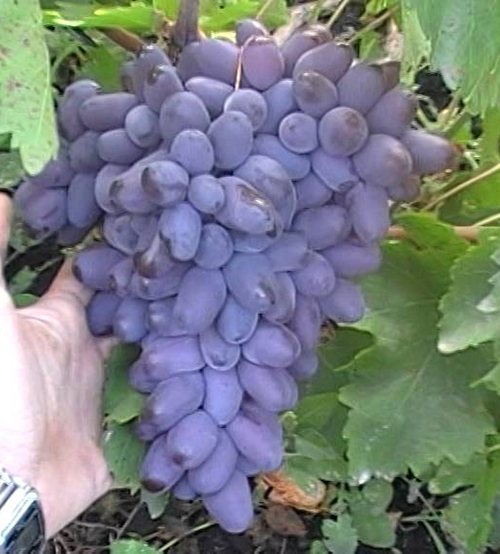

The dark woman
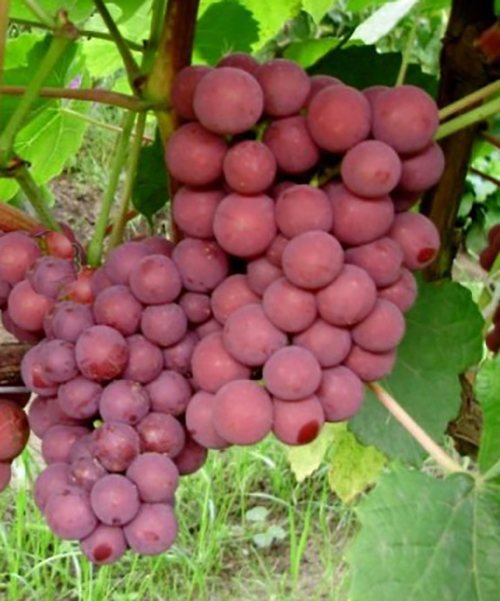

Dvietes zila
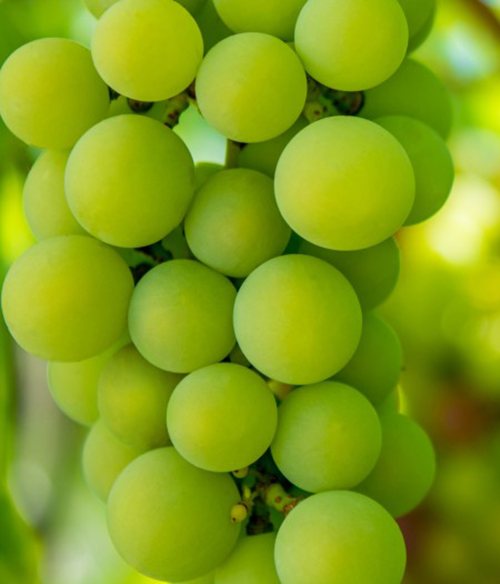

Jubilee Novgorod
There is an opinion that it is very difficult to grow grapes in the Moscow region. But the northern climate gives several advantages - there are not many pests and diseases of this plant, which are common in the southern regions:
Berries
Zilga grape flowers are bisexual. After pollination, medium-sized berries are formed in their place, up to 3 g. The name of the variety indicates the color of the berries. "Zilga" translated into Russian means "bluish". The berries are indeed bluish, purple, covered with a bluish bloom.
Tasters rated the taste qualities of Zilga grapes at 3.2 points. It has notes of the famous Isabella. The pulp of ripe berries is jelly-like, slimy. The juice is purple, aromatic. The Zilga grape variety has a thick skin. User reviews indicate that it is removed from the berry in the form of a bag. Each berry contains 2-3 rather large grains.
On each shoot, 2 or even 3 short loose clusters are formed. On average, there are 1.3 of them per shoot. The shape of the bunch can be conical, with a cylindrical base, less often - lobed or winged. The number of berries in one bunch - up to 50. Weight - up to 120 g, average - 88 g.
On average, up to 12 kg of berries are obtained from one bush.
Zilga grapes ripen at the end of August. Gardeners' reviews say that if the berries are not picked, they will hang for a long time, withering in the sun. If they are not spoiled by wasps, the berries will become sweeter and may even turn into raisins.
How to plant seedlings correctly
First of all, it is worth mentioning that grape seedlings are best bought in specialized vineyards with extensive experience in growing crops. Nowadays, it is very easy to order a vine in the online store. Thus, you will protect yourself from buying an unordered plant, and from low-quality goods, which are easy to change when buying through the network. Then follow the tips:
- Plan your grape planting in the spring or fall. For spring, pre-prepare the site and soil in the fall, for the fall - a month before the appointed date.
- Remember that grapes are a thermophilic plant, for it on the site it is worth choosing the most southern, sunny, windless and tree-free place. If you have young trees in your garden, step back at least 3 meters from them.
- The hybrid is picky about the composition of the earth, but grows best on light, slightly acidic soils with the addition of humus, peat. To prevent root decay, do not choose wet soil with a close ground source of water.
- Level the area, plan the rows.
- Zilga is a tall plant. For him, you will need to first prepare the supports.
- Having received a seedling, take a good look at its root system, determine the quality of the roots by the incision, which should not be brownish-rotten, but light green. Also evaluate the entire purchase as a whole.
- If the roots are dry - which should not be allowed - immerse the vine in water for a day.
- Plant the bushes at a distance of at least 3 meters from each other, step back 1.5 meters in a row. Dig a hole 80x80x80 cm.
- After planting, water the plant abundantly and water regularly throughout the week.


general description
The Zilga hybrid is early ripe, that is, the harvest ripens in 120-130 days. The grafted bush is medium-sized, rooted, reaches a height of two or more meters. The shoots have good growth vigor. Annual lashes have time to mature before the onset of the cold season. The foliage is large, three-toed, dark green in color (the color of the back is slightly whitened). It is dense, rough.


The Zilga grape is a self-pollinated plant. The flowers have organs of both sexes. After flowering, small rounded blue berries, covered with a bluish matte bloom, are formed in their place. The skin is thick and firm. The pulp is jelly-like, slimy, with few large seeds. The taste is estimated at 3.2 points. It has a touch of Isabella. Fruit weight - 6-7 grams. Fruits contain about 20% sugar, and their acidity does not exceed 5 g / l.
By the way! The color of the berries is indicated by the name of the variety. "Zilga" translated into Russian means "bluish".
The berries are collected in 30-35 pieces in loose clusters, of which there are 2-3 pieces on each shoot. They are conical or cylindrical. The brushes are voluminous and weighty. The weight of one medium bunch is 350-450 grams.
Grapes give a good yield - up to 12 kilograms of berries from a bush. Fruit ripening occurs at the end of August. The advantages can also include the feature of berries for a long time not to crumble from the bush. They can hang on long stalks for a long time, withering in the sun. The longer they stay on the bush, the sweeter they will be.
Who is the sweetest in the world
To bring out the best and the bad side of the Zilga grape, it is best to compare it with similar ones. As the main parameter, you can take the ripening of the crop. Lepsna grapes of Lithuanian selection and Cosmonaut of Russian selection are similar to Zilga in this size.
| Zilga | Lepsna | Cosmonaut | |
| Assignment of the variety | universal | universal | dining room |
| The power of growth | big | big | big |
| Ripening of the crop in days from the beginning of the growing season | 100–110 | 100–105 | 100 |
| Fruitful shoots | 85% | 75–80% | 89% |
| Average bunch size in grams | 400 | 170–200 | 220g |
| Average berry size in grams | 4,3 | 2–4 | up to 2.9 |
| Sugar | 18–22% | 22% | 18,4 |
| Titratable acids in grams per liter of juice | 5 | 4 | 4,8 |
| Taste | light nutmeg | easy labrusca | sweet |
| Tasting score in points | 7,1 | 7,1 | 7,9 |
| Resistance to frost in ºС | -25 | -28–30 | -24 |
| Resistant to mildew, mildew, gray mold | high | to mildew, gray rot high, oidium sufficient | to mildew, oidium is unstable |
From the data presented, it can be seen that Zilga is slightly inferior to the Cosmonaut in terms of the number of fruitful shoots and tasting assessment, and Lepsne - in frost resistance and the amount of sugar in berries, but in other characteristics, and especially in resistance to powdery mildew and gray rot, it surpasses them.
Everyone who grows grapes on their site knows how much work goes into caring for this plant, and therefore must be able to cope with a variety of diseases and pests:
Comparable grape varieties in the photo


Zilga grapes
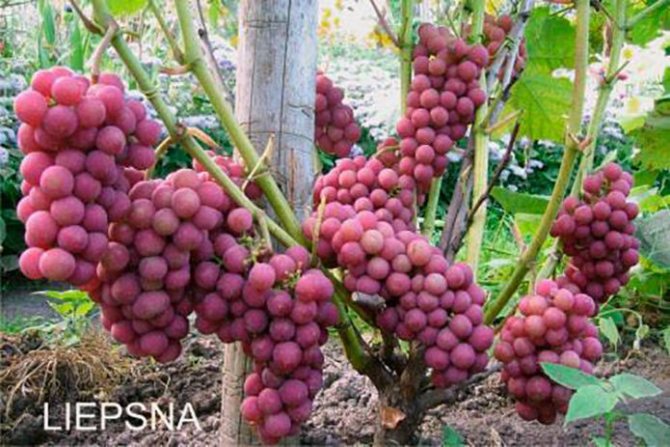

Lepsna grape


Grape Astronaut
Diseases and pests
A characteristic feature of the variety is its resistance to infectious diseases. Careful care will protect against fungal and viral infections, as well as aphids and spider mites. During the rainy seasons, fungal diseases such as mildew, gray mold and powdery mildew sometimes develop. These diseases are manifested by a powdery gray bloom - fungal spores. Sick berries wrinkle, dry out and fall off. And the affected shoots develop poorly, ripen late, and therefore become less winter-hardy.
To protect the vineyard from disease, multiple fungicidal treatments are carried out. Depending on the pathogen, drugs such as Quadris, Folpan, Strobi, Topaz, Kuprozan, Shavit, Polykhom, Acrobat and others are used.
Zilga belongs to those varieties that show high resistance to traditional grape diseases. At the same time, the plant can get sick with mildew, oidium or gray rot, due to rains, too much watering or the proximity of groundwater. In the first few years, after planting, it is recommended to perform two, and, if necessary, three times treatment with a fungicide.
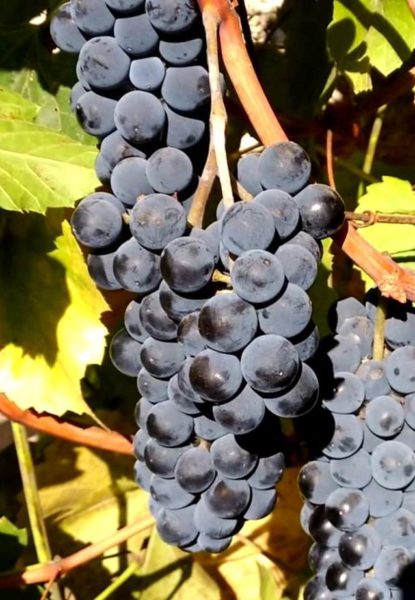

Many gardeners complain about the invasion of wasps and birds. When dealing with insects, we recommend using sweet water traps and making sure that there are no hornets' nests nearby. To protect against birds, various scarecrows are used, in some cases, the bunches are covered with a net.
Early grape varieties (video)
Advantages and disadvantages of the variety
The Zilga grape was bred as a hybrid form that could form a decent harvest of high-quality berries in the difficult climatic conditions of the Baltic countries. The variety has the following advantages:
- the hybrid form is not damaged by wasps;
- unpretentiousness of grape bushes and the absence of the need to carry out normalization of the harvest;
- indicators of resistance to damage by powdery mildew and mildew are 4 points, which involves three standard spraying during the growing season;
- the possibility of growing as a non-sheltering crop in the southern regions of our country;
- high rooting rates of cuttings;
- the versatility of using ripe berries;
- frost resistance of fruit buds up to -29 ° С.
In addition, the variety is characterized by uniformity of berries and good taste. These consumer advantages are complemented by the possibility of transportation and long-term storage of the harvested crop.
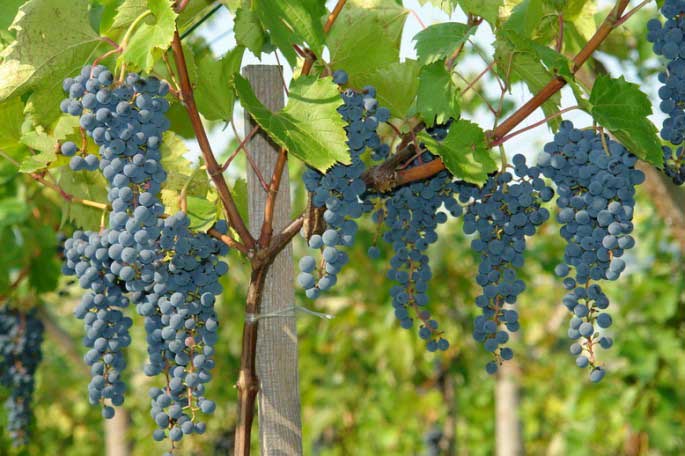

Agrotechnical features
The economic characteristics of Zilgi can hardly be considered standard in terms of unpretentiousness and adaptability to completely different cultivation conditions. Thanks to this, the hybrid can be recommended, including to novice winegrowers, who, even making some mistakes, will be able to get a decent harvest from the plants.
Despite the modest requirements for heat supply, the bushes should still be placed in areas heated by the sun. The slopes of the northern exposures, the lowlands of gullies, valleys, and other places with stagnant cold air are definitely not suitable for planting. In the northernmost regions with very short summers and close to the critical SAT level, grapes are grown in a wall culture protected from arctic winds.
For large areas, southern slopes of sufficient steepness are sought, and a vineyard is laid out in their upper part. Balance should also be shown in relation to the water regime of the soil. On the one hand, the variety responds well to sufficient moisture in the root layer, however, excessively damp, and even more so swampy areas are not suitable for it.
Reproduction most often occurs by rooted cuttings, since in areas where Zilgi is widespread, the soil is not infected with phylloxera. If the planting of grapes is planned in the southern regions, where there is a risk of the presence of root aphids in the soil, the plants should be secured by grafting onto a phylloxera-resistant stock, or by using the appropriate grafted seedlings. The variety's compatibility with the main rootstock forms, by the way, is good.
The choice between a covering and non-covering cultivation system should be made depending on the local climatic conditions, and, above all, the long-term minimum winter temperatures. It will be great if the frost resistance of the hybrid is enough to form powerful high-stemmed bushes, and even better for planting arches and arbors with them.
In this case, you can count on excellent yields and improved fruit quality. If the thermometer in winter often overcomes the mark of -25 degrees, then willy-nilly it will be necessary to cover the grape bushes, and therefore to form them according to squat, standard-less schemes. The results of cultivation in this case will be more modest, but they will delight many winegrowers.
Pruning the plants that have entered fruiting is not difficult. Even the first buds of the variety are distinguished by high fertility, and therefore it is adapted for short pruning by 3-4 eyes, and in general, the load is carried out by 30-40 buds. With large-sized formings, this number can even be slightly increased.


Zilga demonstrates increased resistance to fungal diseases such as mildew, oidium and gray rot, and during the growing season requires only one or two preventive treatments against them. Thus, the harvest from the Latvian heroine can be considered environmentally friendly, which is also an undoubted advantage of her cultivation.
When planning a vineyard, one should take into account the biological characteristics of Zilgi. He likes to grow in sunny areas with sandy or sandy loam soil with a weakly acidic reaction (the pH level should be in the value of 5-5.7) Therefore, if the soil is too acidic, then liming the site will be useful. In the shade, grapes can also grow, but the lack of lighting will greatly affect the quality of the fruit. You should not plant grape seedlings near the walls of houses and next to tall trees that will oppress the grapes with their roots.
Advice! It is best to place the grape bush on the south side of the site, 4-5 meters from the house wall. This will provide maximum coverage and protection from cold winds.
High-quality seedlings should have a well-developed root system, smooth, clean shoots with numerous eyes. Before planting, the roots are soaked in water or a growth stimulator. For better adhesion to the soil, the roots are also dipped in a clay-manure mash.
Before planting, the site is dug up and superphosphate, wood ash and humus are introduced. A deep hole 50 * 70 centimeters in size is dug under each seedling. A bucket of humus is placed at the bottom of the pit and thoroughly mixed in the ground.The seedlings are planted so that the bases of the annual shoots are 3-5 centimeters above the edges of the pit.
As the filling progresses, the earth layers are compacted, spilled with warm water. If cuttings are planted, then 2 pieces are planted in each pit at once. Care for the cuttings should be more careful, as they do not take root well. Due to the fact that Zilga is a vigorous, powerful plant, the seedlings should be planted at a distance from each other.
Fact! The most delicious wine is obtained by growing Zilgu grapes on poor sandy soil.
Caring for a newly planted grape seedling is reduced to systematic watering, top dressing, and loosening the soil. To build up a powerful root system, grapes need a lot of water. In the first year, the plant is watered up to 15 times. The first time the grapes are watered immediately after planting. If the land is pebbly, then the number of irrigations is increased to 18.
Dense soil is watered less often, up to 10 times per summer. It is especially important to pay attention to watering at the beginning of summer and during the ripening of the grapes. Watering is reduced in September. It is preferable to water the vineyard along the furrows dug from both sides of the plant in a thin stream. Each young grape bush requires up to three buckets of water.
It is necessary that the soil is moistened to a depth of 80 centimeters. In the second summer, the plant is watered 8-9 times. In the spring months, water is watered once, since the ground is still sufficiently saturated with snow moisture. In the fall, they are also watered once. And in the summer months you need 2-3 watering. In the third year, the number of irrigations is already 6-7.
After watering, the soil is loosened, at the same time getting rid of weeds. If the soil is poor in nutrients, then in the first year in the fall, manure is introduced into the soil - up to 4 kilograms per square meter. With a well-fertilized soil, fertilizing begins to be arranged only from next year.
Although Zilga is considered a frost-resistant variety, it is still recommended to cover the young vineyard for the winter. The base of the trunk is sprinkled with earth high, sprinkled with foliage. At the end of March, the grapes are opened very carefully so as not to hurt the buds. Then the first deep loosening is carried out to saturate the soil with oxygen. After opening, one-year-old grapes are pruned.
As the bush grows, the vines are tied to a support. Usually, the first garter is carried out from the second year of the plant's life. The best type of support for grapes is considered to be a trellis. Zilga is good because it does not need to be covered for the winter, which means that the need to remove long lignified lashes from the supports is eliminated. In winter, you can only poke the base of the bush so that the roots do not freeze.
Pruning
In the spring, when the shoots reach 10-15 centimeters in length and inflorescences are formed on them, unnecessary shoots are broken out or cut out. Weak and damaged branches are removed, as well as non-fruiting ones. Pruning is necessary to thin the crown so that the bush is not shaded by unnecessary shoots, and the sun and light freely penetrate deep into the bush.
Zilga is characterized by a tendency to form large shoots. If they are not partially removed, then the vine in the lowest layers may not ripen on time and freeze in winter. And even if the frost does not spoil the plant, then the vines themselves will intertwine with each other, tightening into a tight ball. In this case, the yield will suffer.
Prune the grapes short without fear of losing the harvest. On the contrary, the more branches are cut, the larger the bunches will form. On fruiting bushes, when pruning on the uterine sleeve, 4-5 shoots are left for fruiting and 2-4 for replacement. No more than 7 buds should remain on one shoot. On four-year-old bushes, there should be 6 fruiting shoots, and replacement ones - 4.
Advice! Do not rush to prune branches damaged by frost. Chances are that the kidneys will still move away and grow.
A plant that is already yielding a crop requires additional fertilization.The grapes that receive minerals and organics in a complex manner, including also summer dressings, bear fruit better. The main dose of fertilizers includes superphosphate (50 grams) and potassium chloride (6-9 grams per square), which are applied to the soil in the fall during digging. In the spring, after the release of the land, garden shrubs are fertilized with ammonium nitrate (30-50 grams) and ammonium sulfate (60 grams).
Potassium-phosphorus fertilizers can be applied in the spring, if this was not done in the fall. At the end of spring and in the middle of summer, two dressings are arranged:
- 10-15 days before flowering. Add 20 grams of ammonium nitrate (or 30 grams of ammonium sulfate), 25 grams of superphosphate and 4 grams of potassium chloride per square meter.
- 20 days after flowering. Plants are fed with superphosphate (25 grams), potassium chloride (3-4 grams).
Organic matter is applied every 2-3 years. In this case, rotted manure or compost is used in the amount of 5-6 kilograms per square.
What will make Zigla happy
The Zilga grape, universal for its purpose, ripens in 100-110 days after the leaves bloom on the vines. It is one of the fastest maturing varieties in northern viticulture. At the same time, shoots ripen very well on its tall bushes. Of these, up to 85% are fertile.
Zilgi flowers are bisexual, there are no problems with pollination of flowering brushes.
Bunches of average weight (up to 400 g) consist of dark berries, weighing an average of 4.3 grams, covered with purine, which is why their shade, which gave the name to this hybrid form, is bluish. Grape juice is weakly colored.
By the time of harvest, Zilgi berries accumulate 18-22% sugar and up to 5 grams of acids per liter of juice. On the tasting scale, Zilga has a score of 7.1 points.
This form of grapes is resistant to cold temperatures down to -25 ºС, infection with real and downy mildew and gray mold.
Zilga grapes (video)
Planting Zilga grapes
If you are thinking about planting Zilga grapes, then, first of all, we recommend taking care of buying seedlings. However, the variety reproduces well by layering and cuttings - if there is such an opportunity, then these methods can be used.
- When choosing a site, it should be borne in mind that Zilga does not like drafts, besides, when planting vines, preference should be given to the southern side, which is best warmed by the sun;
- Grapes can be planted both in autumn and spring, but the holes should be prepared in advance;
- The planting pit should have a depth of 80 centimeters to 1 meter, with a diameter of about 80 centimeters;
- At the bottom of the hole, form a drainage layer of pebbles, broken brick, expanded clay, or other material;
- Stir black soil with several buckets of humus, add 2-3 tablespoons of potassium, phosphorus and nitrogen fertilizers to the resulting mixture;
- Before planting, place the seedling in water for several days or in a root former for 2-3 hours;
- The seedling is lowered into the hole to the level of the neck, watered abundantly with water and then tamped. After that, the ground around the root is mulched with peat or other material;
- The formation of the Zilga grape bush begins in the second year, after planting.
- Zilga grapes are pruned in the fall or spring. Cutting off the vine, leave 5-7 eyes. It is important to remove dry and diseased branches on time;
- Monitor the cleanliness of the soil around the roots of the plant, remove accumulated debris in a timely manner;
- Apply fertilizers regularly: nitrogen - in early spring, phosphorus - in spring and summer, potassium - in spring for vigor and in autumn, so that the plant can overwinter normally.
If you are planting a rooted seedling from a container, it must be borne in mind that the heel roots are there at a distance of up to 15 cm below the soil level. They need to be placed at a depth of 40 cm.
If this cannot be done due to a too short vine, do not fill the planting hole completely until the vine grows back to the desired height. And it is better to buy a seedling longer than 40 cm.
A pit for planting grapes is dug at least 60 cm deep.Prepare the soil by adding nutrients and trace elements. The Zilga grape variety is a Euro-American hybrid that grows best in neutral soil with a pH of 7. But the presence of an isable hue in the taste indicates a relationship with the American Labrusca species.
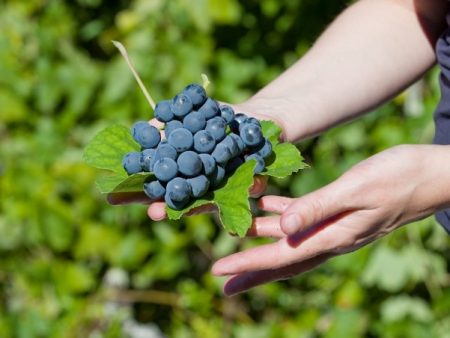

The distance between the bushes is from 1.25 to 2 m in a row. Bushes of the Zilga variety are vigorous, so you need to look at where their crown will be placed.
In the northern regions, Zilga grapes are best planted on the south side of the stone wall. It will protect the bush from the wind, and the sun's rays, reflecting off the wall, will increase the temperature on the soil surface near the bush.
It is necessary to plant a bush so that in the future its base does not stand in the water. Grapes do not like soaking very much.
Advantages and disadvantages of the variety
Latvian grapes are good from all sides. It is extremely undemanding to growing conditions, rarely gets sick and tolerates Russian winters well. It shows good yields annually. And bisexual flowers do not need extraneous pollinators, which makes the hybrid even more attractive in terms of cultivation.
The plant has a fast growth vigor, that is, in a couple of years you can get a fully mature, competitive vineyard. Zilga can be grown as a self-rooted plant, as well as grafted onto absolutely any rootstocks - it easily takes root and grows back quickly already this year. Surprisingly, this variety is hardly touched by wasps, so the crop at the time of cutting almost in 100% of cases has a presentable appearance. And if you let it hang in the sun a little more, then you can get natural raisins.
The few disadvantages most often include too dense skin and large grains inside.
Briefly about the main
- Zilga is a fairly old grape variety that was bred several decades ago. It will fall among the winegrowers due to its positive qualities.
- The variety is considered universal in cooking - wonderful wine, juices, sauces are made from grapes. It is also good fresh as an appetizer or part of a salad.
- The berries have a good presentation, while they have a dense skin, which allows you to transport Zilga anywhere without any problems - the transportability is much higher than average for grapes.
Planting and caring for grapes
The grapes need to be fertilized, but not with granular fertilizers, which contain a lot of salt. From organic it is better to use rotted manure.
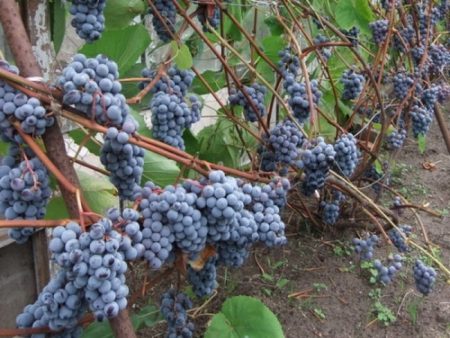

The area where the grapes grow must be completely free of weeds and grass. This helps the earth to warm up better, which is very beneficial for the growth, fruiting and ripening of grapes.
Weeds can oppress grapes, making them grow poorly and endure the winter even worse. Some wild plants release substances that are harmful to grapes.
Some agricultural crops have the same effect: eggplants, potatoes, tomatoes, peppers.
Each bush can be created more comfortable conditions for growth. There are many ways to do this: laying bricks on the bottom of the pit before planting, filling a hill of earth from the north side, using dark plastic bottles, dark film.
Watering the grapes is an important part of caring for the bush. Do not allow the soil to dry out.
Nuances of agricultural technology
Zilga was bred in the Baltic climate, which is rather harsh for this culture, therefore it is rather unpretentious in care, as well as to weather conditions. But there are some nuances of agricultural technology that are best paid attention to:
- When planting, one of the most important points is the seedlings. They should be healthy, have already developed and without any visible damage. If there are any weak shoots, we recommend cutting them off immediately.
- The most vulnerable bushes are those that have just been planted. It is recommended to form it on the trellis from the very beginning.
- The variety does not like mineral fertilizers.Undoubtedly, he needs them, but it is extremely important not to overdo it - once every three years will be enough.
- In general, do not use pig manure for this variety - it may not only not help, but even make it significantly worse.
- If the bushes are not cut in time, then they can break off - more than 35-45 eyes are generally not recommended to be left.
- For the health of this variety, it is necessary to constantly remove weeds - the roots can give them useful substances.
- The grapes are frost-resistant - even fruit buds can withstand severe frosts down to -29 degrees.
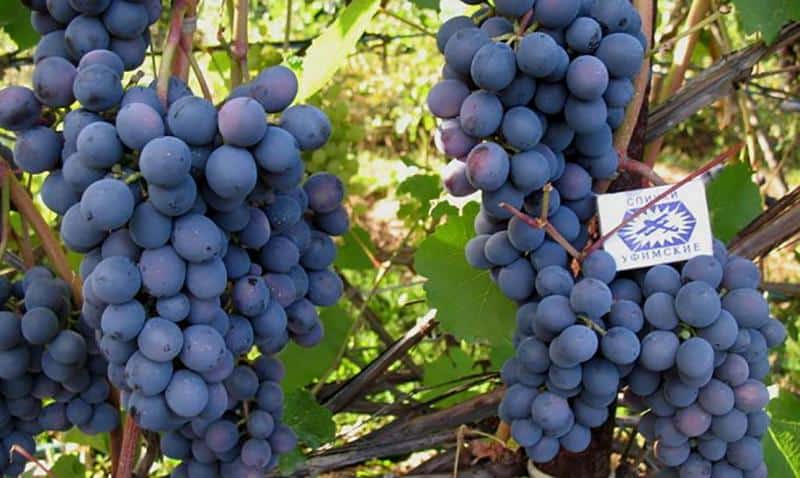

Testimonials
The Zilga hybrid has not yet been included in the State Register, but this does not prevent it from being one of the most popular varieties of our time. Novice growers begin to comprehend the basics with the Zilga grapes. This is no coincidence, because it takes root well on any land and in any climate. It does not require frequent feeding and sophisticated agricultural techniques.
Zilga is convenient because it grows and ripens in our region. The berries, albeit small, but sweet enough, also make good raisins. I cover it for the winter, although they talk about its frost resistance, but I'm afraid. The plant shows resistance to diseases, but wasps cause trouble.
I have been cultivating this variety for ten years - mainly for raisins, juice and jam. There are no problems with grapes care, it only grows quickly - you need to cut a lot. I did not notice a particular tendency to disease, although for prevention I treat it with a fungicide twice a season. The berries have a hard peel, but birds love them - they add worries, I usually cover the plants with a protective net.
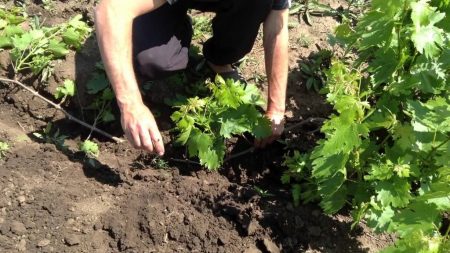

Advantages: high yield, unpretentiousness, resistance to various diseases, good frost resistance;
Disadvantages: hard peel of berries, not the best taste, requires careful pruning, prone to the invasion of wasps and birds.
Comparison with analogues
Let's compare Zilgu with the most popular frost-resistant competitors.
| Sign | Variety | |||
| Zilga | Alpha | Marquette | Amur breakthrough | |
| Ripening period | 102 - 110 days | 110-145 days | 125-130 days | 110 days |
| Frost resistance | -32C | Down to -35 ° C | Down to -38 ° C | -40C |
| Productivity from a bush | 300 - 400 c / ha | 150-180 c / ha | 90-100 c / ha | Up to 100 kg |
| Bunches | 200 - 400 g | 150-250 g | 200-400 g | 200 - 400 g |
| Taste | Isabelle taste and aroma | Sour | Sweet | Simple, harmonious |
| Color | Blue | Reddish brown or purple | Dark blue, almost black | Dark blue |
| Disease resistance | Average | Average | High | High |
| Shelf life | 3-4 months | Up to 1 month | A few months | Up to 1 month |
| Sugar content | 18 – 20% | 15-16% | 25-28% | 23% |
| Acidity | 4 - 7 g / l | 10-11 g / l | 2.9 g / l | 6 - 7 g / l |
Pruning
The grape bush begins to form from the second year of life. Until then, he is allowed to grow freely. In the third year, several of the strongest stems are chosen, which are put on the sleeves. The rest of the shoots are removed. The number of arms is determined by the strength of the bush and the growing conditions.
Like any early variety, Zilga grapes tend to form a large number of lashes. If they are not removed, then in the northern regions the vine will not have time to ripen and will freeze in winter. In the southern ones it will not be damaged by frost, but the bush will turn into a ball of woven branches. Even if the berries are tied there and ripe, it will be extremely difficult to collect them.
It turns out that many more branches are removed every year than are left. Sometimes it even seems that the bush will need to be restored for several years. But this is only good for the bush and the harvest.
Prune the Zilga grapes short. 5-7 buds are left on one lash. Pruning is best done in the fall, before the bushes are covered for the winter. Perhaps, in the spring, some of the lashes will be unusable. Then they can be removed painlessly. But do not rush to remove branches on a bush that has been damaged by frost. There is a high probability that the kidneys will move a little later.
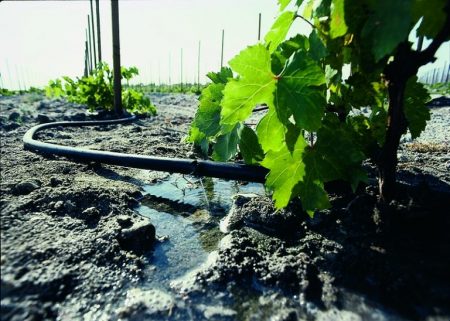

If for some reason it was not possible to prune the grape bush in the fall, do it in early spring.After pruning, the vine will probably “cry”, but the result will still be better than on an uncut bush.
Cropping has another function. Thanks to this operation, the volume of an adult bush can be maintained within the limits you need.
Further care
The main operations for caring for grapes are watering, feeding, shaping and sheltering for the winter.
Watering
Young plants of Zilga grapes are watered 4 times per season:
- After removing the shelter, up to 4 buckets of water, mixed ash in an amount of 0.5 liters, are poured into the installed pipe, and if it is not there, then under the bush. If there is no threat of frost, the water should be warm. If it is required to postpone the beginning of the growing season in order to protect the plants from frost, cold water is taken.
- The second watering is carried out with the formation of buds.
- The third watering is timed to the end of flowering.


As soon as the berries of the Zilga grapes begin to acquire the color characteristic of the variety, all watering is stopped. - The last watering is water charging. It is carried out 7 days before it is planned to cover the plant for the winter.
For adult plants of Zilga grapes, the only watering per season is needed - moisture charging.
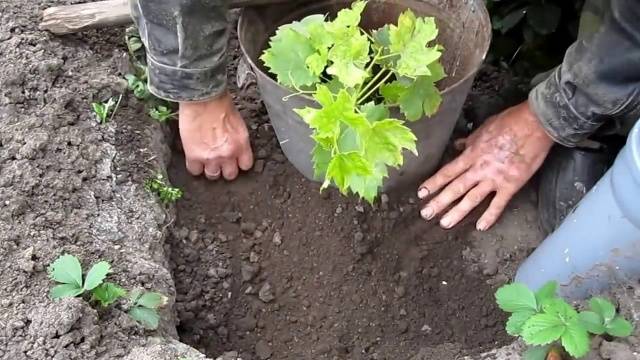

Top dressing
As a rule, the fertilizers applied when planting a seedling are enough for the first three years of the growing season. In the future, it will be necessary to apply both organic and mineral fertilizers. At the beginning of growth, the emphasis is on nitrogen fertilization, in the middle of the growing season, a universal fertilizer is needed, after the formation of berries, Zilga grapes require phosphorus and potassium, after harvesting - only potash fertilizers.
A warning! Do not feed Zilga grapes with nitrogen fertilizers, starting in August. Such feeding will delay the ripening of annual shoots.


Pruning grapes
The main formative pruning is done in the fall. All weak and unripe shoots are cut out, the rest are shortened in accordance with the chosen formation scheme, leaving from 6 to 7 eyes.
Spring pruning is sanitary; shoots that have dried up and grown out during the winter are removed. It is done before the start of sap flow, but always at a temperature not lower than plus 5 degrees.
During the summer, you will need to break out excess shoots, remove stepchildren, chasing grapes, closer to autumn - remove leaves that shade ripening bunches.
To harbor or not to harbor Zilga grapes for the winter? In case of snowless and frosty winters, it is better to insure yourself and build a shelter. It is also necessary for seedlings in the year of planting. In the future, you can do without shelter.
When choosing the type of shelter, it is better to give preference to the dry-air method. Unlike sheltering with the ground, the eyes will not vomit, and the bushes will be reliably protected from frost.
You can watch the video about the experience of growing frost-resistant grape varieties using the Chuguev method:


